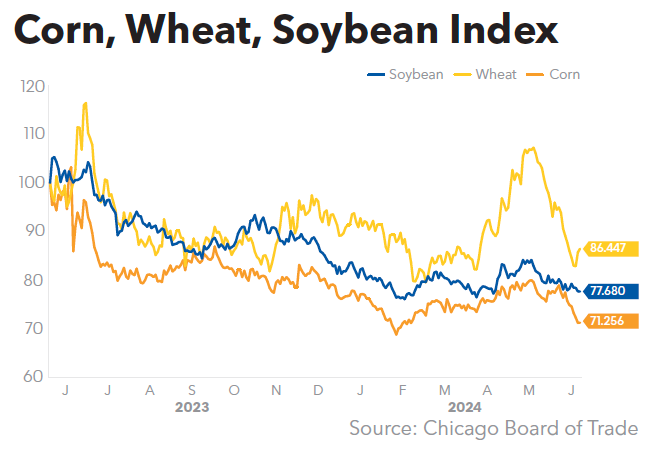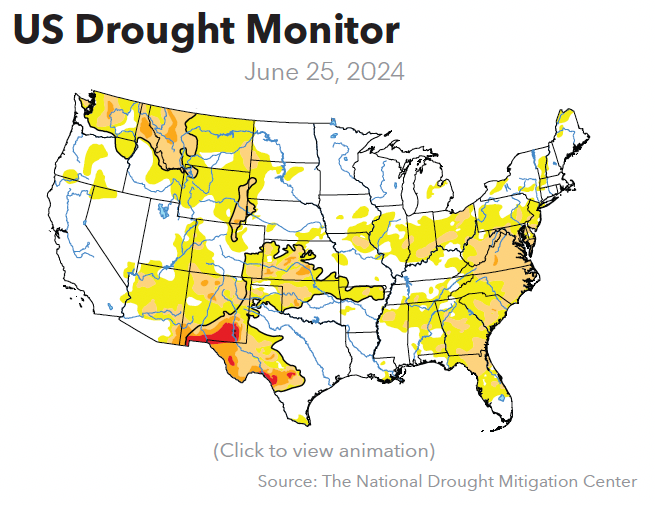Eastern Cornbelt:
Strong thunderstorms swept through the Eastern Cornbelt on June 25-26, causing widespread power outages and prompting thunderstorm warnings and flood advisories in some locations. Michigan was also hit with strong winds and heavy rain during the week.
Winds as high as 65 mph were reported in central Illinois on June 25, and nearly 103,000 Indiana residents were without power as the system swept through that state. Severe thunderstorm warnings were issued for multiple Ohio counties early on June 26, with flood advisories in effect in Ashtabula County due to heavy rain.
Good or excellent ratings were assigned to 60-63% of the corn and 59-61% of the soybeans in Illinois, Indiana, and Ohio on June 23. Michigan crops were in slightly better condition, with 71% of the corn and 62% of the soybeans rated as good or excellent on that date.
Western Cornbelt:
Iowa continued to be battered by frequent and strong storms during the last week of June. Multiple tornadoes were spotted in eastern Iowa on June 25, with reports of damage to outbuildings and trees. Another round of storm activity was expected in central Iowa late in the week, with forecasts warning of damaging winds and up to an inch of rainfall in some locations.
Nebraska was also bracing for potentially strong thunderstorms on June 27-28, while Missouri was expecting high heat, humidity, and an increased chance of storm activity over the coming weekend.
Fully 79-82% of Nebraska’s corn and soybeans were rated as good or excellent on June 23, along with 74-77% of the acreage in Iowa and Missouri. Missouri’s cotton crop was 56% good or excellent on that date, while rice acreage in the state was rated at 72% good or excellent.
Southern Plains:

Hot weather sparked thunderstorms across Oklahoma and Kansas as the week progressed, with forecasts warning of potentially severe storms in eastern Kansas by the weekend.
Heat advisories were issued at midweek for all of north and central Texas, with triple-digit highs reported in Dallas-Fort Worth and lows staying in the 80s. Forecasts warned of heat index readings in the 105-110 degree range over the weekend in Dallas-Fort Worth.
Patches of extreme-to-exceptional drought were reported across western Texas and southern New Mexico during the week, with larger areas of moderate-to-severe drought showing up in northern New Mexico, central Oklahoma, and western Kansas.
Cotton planting as of June 23 was 91-96% complete in the Southern Plains, with sorghum planting estimated at 80% complete in Colorado, 86% in Kansas, 91% in Oklahoma, and 98% in Texas. Growers also had 82% of the sunflowers planted in Colorado and Kansas, while the regional winter wheat harvest had progressed to 95% complete in Oklahoma, 74% in Texas, 53% in Kansas, and just 1% in Colorado.
South Central:
Strong thunderstorms rolled through parts of Arkansas and Tennessee at midweek, sparked by temperature in the 90s and high humidity. Another round of high heat and humidity was in the weekend forecast for the region.
Louisiana’s bayou parishes picked up as much as four inches of rain at midweek, causing localized flooding, with strong storms also reported in parts of Mississippi on June 26. High heat was on tap again for the weekend, with highs expected in the 90s across Louisiana and Mississippi.
Corn in Kentucky and Tennessee was 65-69% good or excellent as of June 26, with soybeans in those two categories totaling 88% of the acreage in Louisiana, 71-72% in Arkansas and Tennessee, and 63-66% in Kentucky and Mississippi. Louisiana’s cotton crop was fully 96% good or excellent, compared with 70-72% in Arkansas and Mississippi and 57% in Tennessee, while rice in the good or excellent categories totaled 82-88% of the crop in Arkansas and Louisiana, 77% in Texas, and 48% in Mississippi.
Southeast:
High temperatures prompted heat advisories across the Southeast in late June and stressed crops as emerging drought conditions expanded across the region.
The US Drought Monitor said most of Virginia and North Carolina were experiencing moderate drought during the week. Severe thunderstorm watches and warnings were in effect at midweek in central Virginia, central Florida, and Alabama, while temperatures in Georgia rose to the upper-90s and triple digits.
Just 30-34% of North Carolina’s corn and soybeans were rated as good or excellent during the week, with fully 49% of the corn and 28% of the soybeans rated as poor or very poor. Cotton in the good or excellent categories totaled 75% of the crop in Virginia, 69% in Alabama, 59% in Georgia, 50% in South Carolina, and 40% in North Carolina.
Fully 90% of Virginia’s peanut crop was rated as good or excellent as of June 26, compared with 71% in Alabama, 48% in North Carolina, and 57-59% in the rest of the region.
